
Sports Illustrated on Skateboarding – 1975
Oh the things I find to buy when I’m actually looking for something else. A positive balance on a PayPal account does not last long when I’m scrolling through skateboard related ephemera. This is the September 1975 issue of Sports Illustrated, with a feature called “Wheeling and Dealing.” Scanned and ran through the OCR for your enjoyment. File it under Things I buy so you don’t have to.
This article mentions the state of the industry, the bust of 1966 and the very recent (at the time) history of the urethane wheel, so it’s a little more interesting than I thought it would be. The article has been converted to HTML for easy reading at the end.
Here’s a few closeups of the photos. Curiously, neither the photographer or the skaters are credited in the captions.
Here’s the cover. This guy Brian Oldfiled broke a record of some kind or other. I thought this magazine might have some other interesting bits in it, but aside from an ad with an unusual photo choice it was pretty dull.
Wheeling and Dealing
Remember skateboards? They are back, and better this time around – by Sarah Pileggi
There is a mysterious phenomenon I that occurs once in a while where-by our world becomes filled, seemingly overnight, with Super Balls or Hula-Hoops or Beethoven sweat shirts. You wonder where they came from and how every kid in town found out about them at the same time, and before you have it figured out they are gone, never to be seen again except at a garage sale.
Sometimes an item that starts out looking like a 90-day wonder becomes a staple. Like the Frisbee. But generally when a fad fades, the entrepreneur with a warehouse full of, say, puka shells, had better hope an esoteric industrial use for the things turns up, because he is surely never going to sell another necklace.
Ten years ago there were a lot of ware-houses full of skateboards. The fad had started in Southern California’s beach towns, where kids nailed roller-skate wheels to miniature wooden surfboards and whiled away the days when the ocean was flat, scaring the daylights out of passing motorists. The craze swept inland (to Southern Californians inland is the United States east of the Hollywood Hills), and for a year anybody who could tool up fast enough made money.
That was 1965. Fifty million skateboards were sold that year. Manufacturers sponsored teams; a promoter was able to sell out a park in Anaheim at $5 a head for what he called the International Skateboard Championships; orthopedists coined a term, skateboard fracture, for a shattered elbow. And by January 1966 it was all over. The skateboard was a good toy, but the kids had pushed it to its limits and were on to new challenges.
Today, against all odds, America is in the grip of a Great Skateboard Revival. At least Southern California is in its grip, and, as everybody knows, what’s hot in Hermosa in August will be dynamite in Des Moines by Christmas. There may be as many as two million skateboards already rolling around Southern California alone and 2,000 to 5,000 more being turned out each day, says James O’Mahoney, publisher of Skateboard magazine. The first pro skateboard competition is scheduled for the LA Sports Arena this month and TV may cover.
The revival began because a freshman engineering student at Virginia Polytechnic Institute, Frank Nasworthy, joined a political demonstration in 1970 and was suspended from school. Nasworthy is 24 now and lives in Encinitas, Calif. He describes himself as “basically a surfer,” but in the annals of skateboarding he will go down as the man who invented the wheel. Out of school and disillusioned, Nasworthy took to hanging around a small plastics company in Purcellville, Va. called Creative Urethane Inc., which was bankrolled by a company called Roller Sports, Inc. One of Creative Urethane’s products was a clear, amber-colored, cast-molded polyurethane rollerskate wheel for use on rental skates at roller rinks.
The urethane wheel had been around for several years, but it had not been a great success. Though durable, it was too slow for the tastes of rink skaters, who preferred hard composition clay wheels, brittle and fast. But Nasworthy realized that a modified polyurethane wheel, with its remarkable traction, could be adapted to skateboards, making them more versatile than they were with the old wheels of steel or clay.
By 1973 Nasworthy was in California and in business, having formed the Cadillac Wheels Company on $700 he had accumulated working in a restaurant. Creative Urethane made the wheels to his specifications, and Nasworthy began to peddle them to surf shops up and down the coast. Most people in the surfing business recognized the possibilities of the urethane wheel immediately, and the rush was on. Metaflex, a Canadian company, developed a wheel of its own. Surfboard manufacturers began whipping out fiberglass, wood, aluminum and molded plastic skateboards, and the business of making trucks, the metal suspension assemblies that join the wheels to the boards, burgeoned.
By word of mouth, then through ads in surfing magazines, the news spread, first to surfers, then to the bicycle set. Kids who had not been born in time for the first skateboard boom and 18-year-olds returning to a childhood pastime all had to have urethane wheels. Ten-year-olds became authorities overnight on skateboard components—boards from Bahne (pronounced bane), Hobie, Hang Ten, Gordon & Smith, Logan, Mojo; trucks by Sure Grip, Bennett, X-Caliber, Chicago; wheels from Roller Sports, Cadillac, Metaflex. And scores more. Nasworthy, who has thrown in his lot with Bahne, one of the largest manufac-turers, says that skateboarding has the potential to endure because “It’s a real sport now.” He assists Bahne and Hang Ten in their joint promotional efforts, specifically the hauling of a 10-ton skateboard ramp from town to town.
The ramp is 12 feet high, 24 feet wide and 150 feet long, with electrical timing gates and slalom courses laid out side by side. Two competitors, wearing crash helmets, skate the courses in two heats for the fastest total time, the idea being to forward the causes of safety, uniform competition and, of course, Bahne, Cadillac and Hang Ten products.
“There are 200 manufacturers in the business right now,” says Nasworthy. “In a year or so there will probably only be five. The big ones.”
At Steve’s South Bay Sporting Goods store in Torrance, Calif., four adolescents, ages 12 to 17, gathered around a glass case filled with wheels and trucks the other day. Overhead hung samples of fully assembled boards that ranged in price from $10 to $40, depending on their components. This day nobody was buying. Marty Edgely, 15, had a bent axle and wanted to know if Steve Urman, the shop’s owner, was going to replace it free. Greg Myers, 12, was looking over trucks while standing on a skateboard fashioned from a sawed-off cross-country ski made, probably decades ago, in Auburn, Maine. Greg did not know what a cross-country ski was, or where this one came from. All he knew was that it flexed dramatically, and he had fitted it out with X-Caliber trucks and Roller Sport “Stokers,” the largest and apparently most popular wheels. As Greg glided out continued the door on his errant ski, Marty Edgely watched. “Look at him on that goofy-lookin’ board,” he sneered.
Brent Hedgecock’s axle was bent, too. He said it was from “riding pools.” Skateboarders talk a lot these days about riding pools. Most of them have never done it, but they have watched it in skateboarding movies and have absorbed the experience as their own. Pool riding is a spectacular stunt. It requires an empty swimming pool, the kind where the walls curve up from the bottom, and the skill to sweep seven or eight feet up those nearly vertical walls and hang for a second, face down and horizontal, before flashing down again into a recovery as breathtaking as the ride itself.
One of the most celebrated pool runners is a seraphic-looking 14-year-old, Greg Weaver of Encinitas. Weaver and 17-year-old Glenn Woodruff, another rider of the horizontal persuasion, perform exhibitions wearing the colors (T shirts) of Hobie boards of Dana Point—the ubiquitous Hobie of surfboards, catamarans and radio-controlled gliders. In exchange, the boys and the rest of the Hobie team—or the Bahne-Cadillac team or the Logan Earth Ski team or any of the others—receive free equip-ment and a whole lot of glory.
It is the new, softer, polyurethane wheel that has made pool riding and a dozen other stunts possible. “The wheels are smooth and quiet, and when you turn they grip the ground,” says Steve Urman. “It used to be that if a kid hit so much as a cigarette butt he and the board would go flying in separate directions. Urethane can roll right over a rock because it displaces, it spreads the weight evenly.” With the new wheels one would assume that skateboarding in its reincarnation would be a safer sport. But this past June, Childrens Hospital of Los Angeles treated more fractures than it had during any month of its 74-year history, and the majority of them were skateboarding injuries. San Diego and several smaller cities have banned the board from streets and sidewalks, and the city of Los Angeles wiped out the already legendary Toilet Bowl, an enormous storm drain basin high in the foothills above Universal City, by laying concrete speed bumps across its surface.
As always, though, the kids have a step or two on the city fathers. They talk of a 14-mile run in Palos Verdes where someone was clocked at 47 mph. They whisper of a long, winding downhill called Spyglass that passes through a housing development where the residents, so far, have not complained. There is the Funnel, a concrete roadbed leading to a concrete riverbed, in Gardena. There is Big Blackie, the low, blacktopped slope that rings the playground of Paul Revere Junior High in Pacific Palisades. It is said that in San Diego skateboarders even fly down the circular ramps of multilevel parking garages.
Skateboarders, both in California and along the East Coast, where the fad began to take hold about three months ago, tend to be junior high and high school students, most of them too young to drive. Skateboarding is not only their avocation but, combined with city buses, their transportation. A board has advantages over, say, a 10-speed bike. It can be carried into a movie or stashed under the stool at a hamburger stand, and it is considerably less attractive to thieves.
At Paul Revere one August afternoon Chuck Askerneese, 15, and Clyde Grimes, 16, having been kicked off Big Blackie by the school’s custodian, retreated to a slope between a classroom and a covered lunch area. Askerneese uses a $40 Bahne. Grimes made his own wooden board and tries to imitate, on hard ground, the surfing style of his idol, Larry Bertelmann of Hawaii, whom he has seen only in movies.
The hill they rode drops once, then levels and drops again. It is 15 feet high and 50 feet wide, with a tree growing out of its exact blacktopped center. Askerneese and Grimes swooped and criss-crossed the little hill, creeping forward and back like cats on their 27-inch boards. They rose and squatted and rose again with all the grace of good surfers. They practiced 180-degree turns, and 360s and 720s, cutbacks and snapbacks, sliders and back-and-forths until the custodian caught up with them again.
At the Funnel on a hot Saturday morning, Terry Craigmiles, nine, stood at the top of the hill watching Frank Hester, 13, sweep across the rough concrete walls that line the roadbed, making it look easy. Terry had arrived minutes earlier, had taken his first shot at the Funnel and lost. Both his forearms were scraped and bleeding.
The Funnel is dangerous, but probably less so than the streets around it. At the Funnel one risks falling. On the streets one risks a fall, a car and a cop. Some people in the business fear skateboards will be legislated out of existence as more and more streets and playgrounds are declared off limits. Others fear that low-quality equipment being sold in increasing volume to discount stores is going to nullify the advances in technology that have been made by the small manufacturers selling through surf and sporting-goods shops. And everybody fears the repetition of the Crash of 1966.
Everybody, that is, except the kids. Phil Johns still gets up at 10 at home in Harbor City and catches the bus to the end of the line at the Redondo Beach pier, just as he has every day since school let out in June. All day long, until it is time to catch the 6:30 bus back home, he does, for the enlightenment of the tourists and his peers, the things that he does best—nose wheelies, tail wheelies, sliding 360s, coffins, back-and-forths. His pants hang low on his thin hips and his skin is evenly brown except for the raw pink of his chronically peeling nose and the scabs on his splayed, dirty feet.
One of these days a tourist is going to get in his way, or a car is going to back into his path, or he will develop a case of “the high-speed wobs” coming down the Torrance Boulevard hill, but for now it feels good to be good, and consequences are for the contemplative.
END
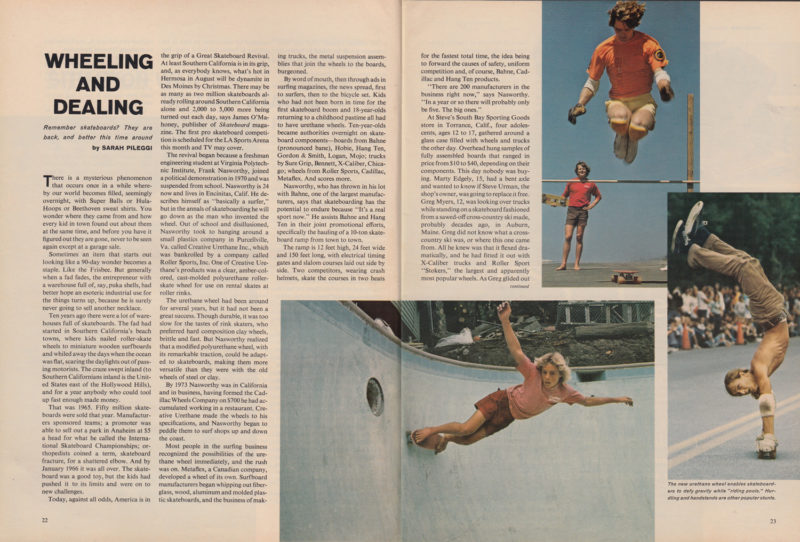
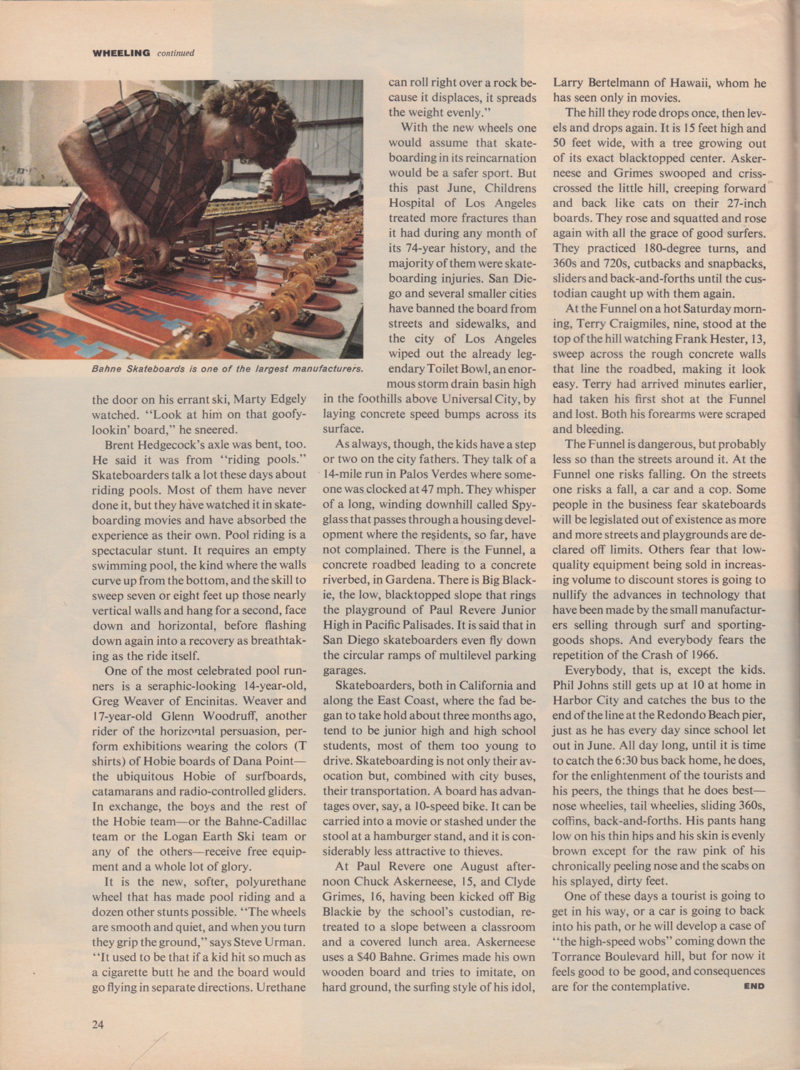
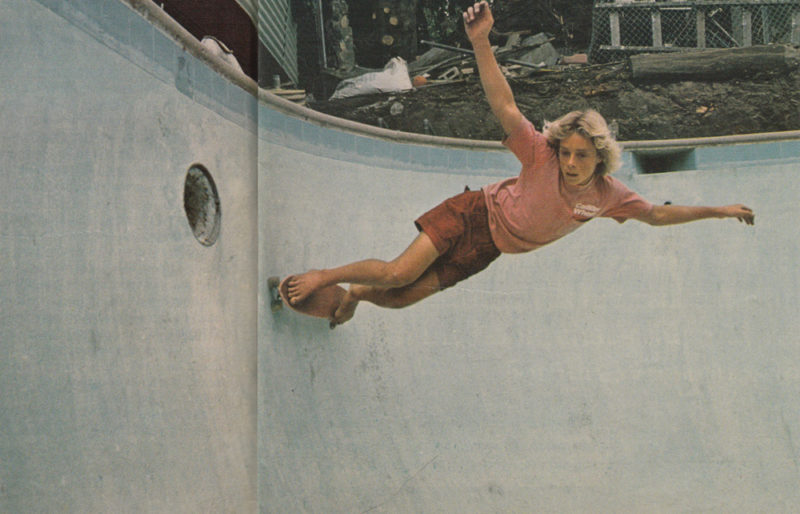

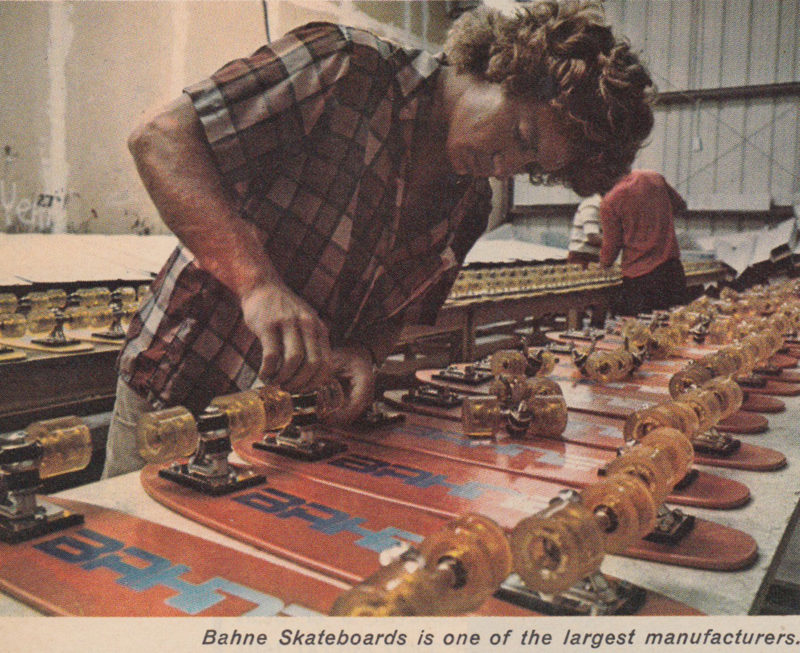



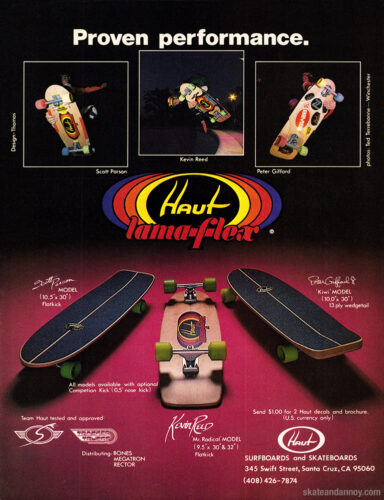
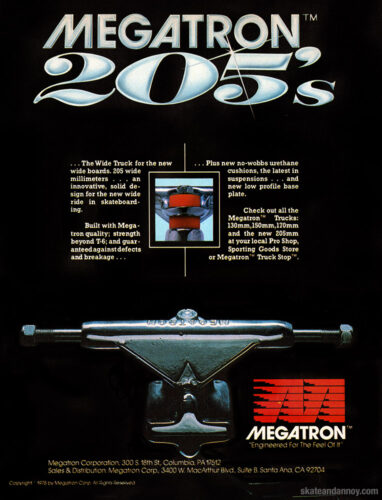
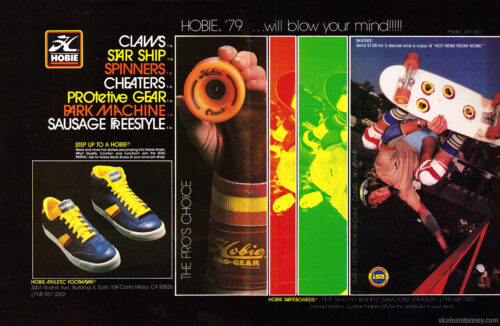





Thanks for sharing this. The guy in the pool looks very much like Gregg Weaver, who is mentioned in the article.
Oh, that’s unmistakably Gregg Weaver. In timing and composition, it’s very similar to his cover on the first issue of the “modern” SkateBoarder mag (Vol. 2 No. 1). See https://skateboarding.transworld.net/wp-content/uploads/2017/06/Front-Cover-3.jpg
Regarding the captions, SI rarely if ever credited the photographer on the pages themselves. Instead, they listed photographers’ names in a separate credits section in very small print, I think near the front of the magazine. As for not ID’ing the skaters, well, my guess is the editors were satisfied enough that the photos illustrated the activity itself. In other words, they were going for showing a typical example or category rather than an individual.
I’d guess Denis Shufeldt as the high jumper, and Ed Nadalin looking on.